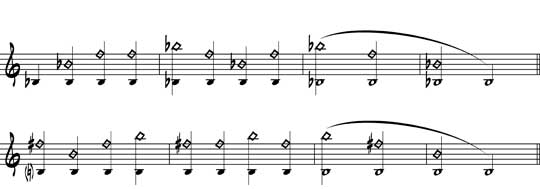Improve Your Tone the Fast Way with These Overtone Exercises

Most people have heard of overtones and have gotten the idea that they can be a helpful practice tool. That is definitely true, but why? How does transforming your saxophone into a bugle help you? While the answer is fairly simple, it takes some basic knowledge about acoustics to fully grasp what’s happening. Understanding what’s happening acoustically will help you be aware of what you’re working towards.
When you are playing saxophone there are two essential columns of air working together to produce your sound. One of these air columns is the vibrating air inside your saxophone which sends out the sound waves we hear and enjoy (at least we hope so). The other is the column of air inside your lungs, throat, and mouth as you blow. So far, so obvious. What’s less obvious is that the air inside of your body is also vibrating. Not only is it vibrating, but it is matching the vibration of the air inside the saxophone exactly. For example, the higher you play on the saxophone the faster the air in your saxophone AND in your body vibrates in tandem.
Because the vibrations of the two air columns match each other, you can affect the saxophone’s timbre and pitch by using the muscles in your mouth and throat to shape the vibrating air columns. This technique is called voicing, which can help your playing in numerous ways and avoid various pitfalls.
What You Want to Avoid
When you don’t use good voicing technique you sabotage yourself. For example, it’s possible to not sufficiently accommodate the body’s air column. If the vibrating air column, also called a standing wave, inside of you can’t vibrate how it wants to then the wave in the saxophone and resulting sound are compromised. A simple illustration is when you don’t take a deep enough breath and low B-flat refuses to sound. You havenÏt provided enough space inside your body for the low B-flat wave and instead you get B-flat an octave higher or something even higher than that.
In less extreme cases where you still get the note you meant to, a less than ideal space and shape inside of your body still affects the wave inside of the saxophone. The effects can include bad intonation and a muted timbre. It can also result in a tighter than ideal embouchure, which further diminishes and distorts your sound.
Voicing for Projection, a Richer Sound, and Extended Range
Using voicing technique you can learn to move the muscles in your mouth and throat to help create the exact wave you need for any given note or inflection. Guess what happens when you do that? The sound projects more as the two standing wave take their ideal shape. Not only is it easier to produce a big sound, but the timbre also includes more overtones creating a richer and more colorful sound.
Voicing technique also takes you into the altissimo register, and much more fluently than the embouchure ever could. Depending on how you shape your throat and mouth, you can make the saxophone sound at a higher pitch than what is typical for a given fingering. By decreasing the space in your mouth and increasing the pressure, you force the wave to vibrate at a higher partial, in other words the next overtone up. This is what overtone practice boils down to, and that is why it can be so helpful for developing altissimo. It teaches you to manipulate the muscles in your throat and mouth in such a way that leads to a near four octave range.
Pumped to Practice Overtones?
There are a lot of different ways to practice overtones. Keeping focused on a rich and beautiful sound will allow you to get the most out of your overtone practice. Long overtones and variations of them using vibrato, dynamics, and other techniques are an important staple of efficient overtone practice.
One excellent exercise for players who have already developed some ability to play overtones, is to play each overtones for 30 seconds. Start at the bottom of a series and work your way up. Use a stopwatch to keep track of time, but focus on sound quality. Listen carefully and try to shape the timbre so that it is colorful and undistorted. Go as high in the series as you can comfortably play. When you start to hear tension in the sound or feel straining in the technique, take a break and then go on to something else.

I have found that one way to check your technique and work towards better technique is lip vibrato. As you’re playing a long overtone use lip vibrato and listen to hear if the vibrato sounds fluid and easy. If the vibrato instead sounds distorted as it descends each pulse, it indicates that your technique is not ideal. At that point, spend some time playing lower overtones. Lower overtones are easier to voice correctly and help warm up your technique for the higher overtones.
Another great way to practice overtones are in scale form. Slurring from one overtone to the next while maintaining a good sound can help improve voicing and embouchure technique. Also, bugling exercises are a great way to practice accurately pinpointing various overtones. Below are two intermediate examples from my book, A Complete Approach to Overtones: Vivid Sound and Extended Range.

Other Approaches and Aids
Extending the range of overtones you can play or learning to play them for the first time can sometimes be challenging. In the PDF that follow is an excerpt comes from “Overtone Training Wheels”, which includes aids to help beginners and intermediate players reach new overtones. These aids can be seen as stepping stones which help you work towards eventually hitting the overtone without the ‘training wheels’.
The PDF also includes an excerpt from “Major Scales in Thirds”, which works on a technique that is more challenging than either scales or bugling exercises. The last excerpt in the PDF is “Slurring into an Overtone from a Lower Overtone”, the most challenging of the techniques presented so far.
DOWNLOAD PRINTABLE PDF WITH THESE AND MORE EXERCISES
A Complete Approach to Overtones: Vivid Sound and Extended Range
These excerpts come from A Complete Approach to Overtones, which is a text completely dedicated to various unique methods of practicing overtones, each with their own merits. These include no-octave key exercises, scale and arpeggio based exercises, long tone variations, bugling exercises and melodies, and slurred transitions. Typically each section of the book begins with the easiest version of an exercise, which may be suitable for a beginner or intermediate player, and then advances to increasingly difficult versions of the exercise. Each section generally ends with versions of the exercise suitable for advanced and professional players. The purpose of the book is to use these efficient and varied methods to improve sound, technique, and range for players of all levels.
Last Thoughts
Overtones obviously aren’t everything you need to practice, but they are one of the most efficient and helpful tools for improving tone, control, and range. A couple years after I had gotten out of high school I had a lesson with Chris Potter, and he told me the most important thing that I personally needed to improve was my sound. He then proceeded to show me how he played each overtone for about 60 seconds each. At the time I didn’t fully grasp the importance of what he was telling me was, but after years of experimenting, I’ve found overtones vital to maintaining my ideal tone technique and continually improving it (and my range). Along the way I’ve discovered some details and methods that I find particularly helpful, and with each discovery my saxophone playing becomes more consistent. I’d suggest that every player takes some time to pay closer attention to their tone and technique for at least part of their practice. You are bound to make discoveries that not only improve your tone but also benefit your playing overall.
Learn More About Overtones with Ben’s New Book, A Complete Approach to Overtones: Vivid Tone and Extended Range
Ebook: http://ben-britton.com/complete-approach-to-overtones/





